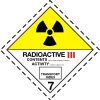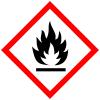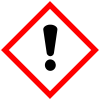Radioactive substances are materials that emit radiation.
YouTube Encyclopedic
-
1/3Views:1 1861 9782 641
-
Dangerous Goods Class 6 - Toxic & Infectious Substances
-
CDL Hazardous Materials HAZMAT Endorsement Exam Questions and Answers Part 2
-
Safety Training - DOT/IATA Recertification (Shipping Dangerous Goods)
Transcription
Divisions

Any quantity of packages bearing the RADIOACTIVE YELLOW III label (LSA-III).
Some radioactive materials in "exclusive use" with low specific activity radioactive materials will not bear the label, however, the RADIOACTIVE placard is required.
Placards
|
Compatibility Table
| Load and Segregation Chart | ||||||||||||||||||||||
|---|---|---|---|---|---|---|---|---|---|---|---|---|---|---|---|---|---|---|---|---|---|---|
| Weight | 1.1 | 1.2 | 1.3 | 1.4 | 1.5 | 1.6 | 2.1 | 2.2 | 2.2 | 2.3 | 3 | 4.1 | 4.2 | 4.3 | 5.1 | 5.2 | 6.1 | 7 | 8 | |||
| A | B | A | ||||||||||||||||||||
| 7 - I | N/A | B | ||||||||||||||||||||
| 7 - II | N/A | B | ||||||||||||||||||||
| 7 - III | Any Quantity | B | O | |||||||||||||||||||
| Key | ||||||||||||||||||||||
The absence of any hazard class or division or a blank space in the table indicates that no restrictions apply.
| ||||||||||||||||||||||
References
- ^ Federal Emergency Management Agency; United States Department of Energy (June 2010). "Radioactive Materials - Transport and Incident Response" (PDF). p. 14. Archived from the original (PDF) on 8 May 2017. Retrieved 20 July 2019.
- ^ Pipeline and Hazardous Materials Safety Administration (PHMSA) (October 1, 2011). "49 CFR 177.848 - Segregation of hazardous materials" (PDF). Government Publishing Office. p. 853. Archived from the original (PDF) on 16 July 2019. Retrieved 16 July 2019.
- 49CFR 173 Subpart I




